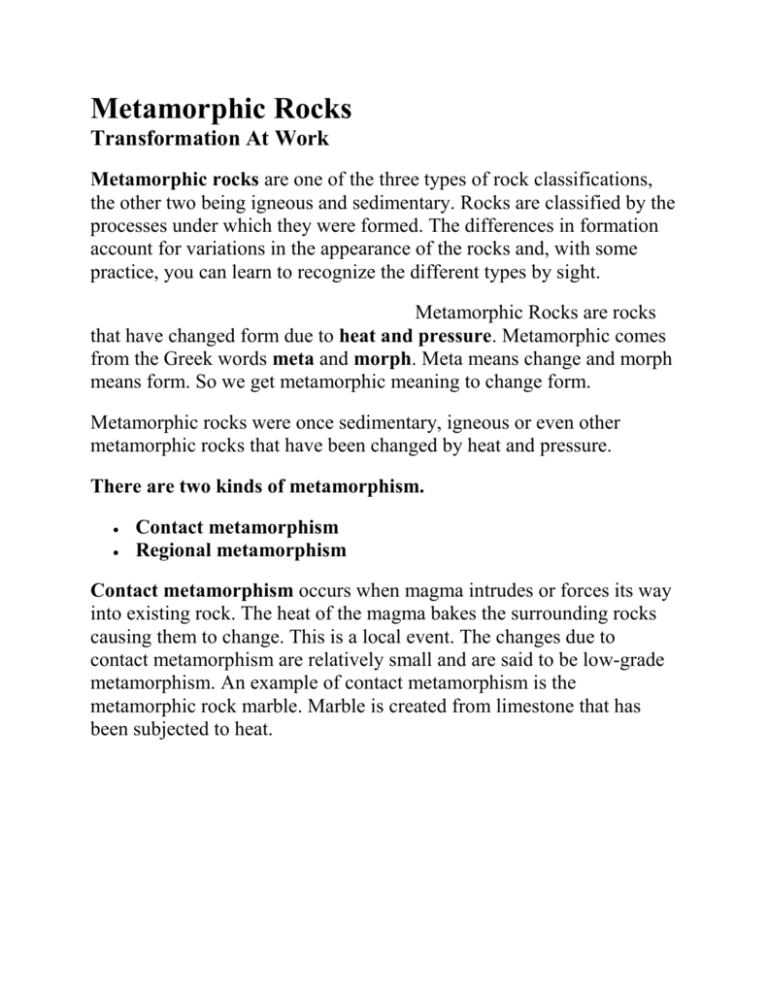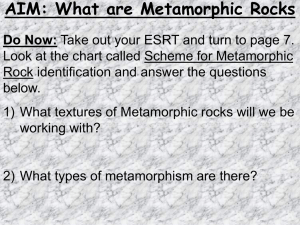Metamorphic Rocks Transformation At Work
advertisement

Metamorphic Rocks Transformation At Work Metamorphic rocks are one of the three types of rock classifications, the other two being igneous and sedimentary. Rocks are classified by the processes under which they were formed. The differences in formation account for variations in the appearance of the rocks and, with some practice, you can learn to recognize the different types by sight. Metamorphic Rocks are rocks that have changed form due to heat and pressure. Metamorphic comes from the Greek words meta and morph. Meta means change and morph means form. So we get metamorphic meaning to change form. Metamorphic rocks were once sedimentary, igneous or even other metamorphic rocks that have been changed by heat and pressure. There are two kinds of metamorphism. Contact metamorphism Regional metamorphism Contact metamorphism occurs when magma intrudes or forces its way into existing rock. The heat of the magma bakes the surrounding rocks causing them to change. This is a local event. The changes due to contact metamorphism are relatively small and are said to be low-grade metamorphism. An example of contact metamorphism is the metamorphic rock marble. Marble is created from limestone that has been subjected to heat. 2 Regional metamorphism by contrast takes place over large areas and is high-grade metamorphism. Regional metamorphism is associated with mountain building like these rocks on the cliff face of the Black Canyon of The Gunnison. It is mostly a metamorphic rock called gneiss. See picture below. The pink rocks you see are pegmatites which are igneous rocks that have squeezed their way into cracks in the older gneiss. 2 The Causes or Agents of Metamorphism The causes or agents of metamorphism are heat, pressure, and hydrothermal solution. But where does this heat and pressure come from? And what is hydrothermal solution? Well read on… The heat and pressure comes from inside the earth. From the upper mantle up to within a few kilometers of the surface of the earth there is a tremendous amount of heat and pressure. This heat and pressure increase with depth. It is estimated that the temperature increases about 20o to 30o C per kilometer of depth. Plate Tectonics Adds Heat And Pressure There is something else that adds to both the heat and pressure, and that is plate tectonics. When the plates of the earth collide, they squeeze the rocks at the borders with unbelievable force. This force increases the pressure in this and surrounding areas. Friction is also created by the plates grinding together. This friction generates enough heat to melt the rocks at the point of contact. Heat For metamorphism to occur energy is needed to fuel the chemical reactions. Heat is the primary source of this energy. Pressure The pressure within the earth is the result of gravity pulling the crust of the earth downward.Like heat, pressure increases with depth. This pressure can actually squeeze the spaces out of the minerals within the rock. This makes the rocks denser. The heat and pressure together cause the rock to flow instead of break or fracture. The mineral grains become realigned. They flatten out and get longer. Hydrothermal Solution Magma contains many different gasses including H2O. That’s right water! Or more properly steam. Minerals are carried by the steam. When this hot fluid escapes from the magma it is called Hydrothermal Solution. These hot fluids can change the crystallization in rock by dissolving the minerals and then depositing new ones. Rocks that come in contact with this hydrothermal solution can have their composition altered as a result of this recrystalization. The Classification of Metamorphic Rocks Metamorphic rocks are classified as foliated or nonfoliated. Foliated metamorphic rocks appeared banded or layered. Nonfoliated metamorphic rock usually contains one mineral. It is uniform in texture.








